Abstract
1. In decerebrated, non-spinalized rabbits, intrathecal administration of either of the selective 5-HT1A-receptor antagonists (S)WAY-100135 or WAY-100635 resulted in dose-dependent enhancement of the reflex responses of gastrocnemius motoneurones evoked by electrical stimulation of all myelinated afferents of the sural nerve. The approximate ED50 for WAY-100635 was 0.9 nmol and that for (S)WAY-100135 13 nmol. Intrathecal doses of the antagonists which caused maximal facilitation of reflexes in non-spinalized rabbits had no effect in spinalized preparations. 2. In non-spinalized animals, intravenous administration of (S)WAY-100135 was significantly less effective in enhancing reflexes than when it was given by the intrathecal route. 3. When given intrathecally, the selective 5-HT 2A/2C-receptor antagonist, ICI 170,809, produced a bellshaped dose-effect curve, augmenting reflexes at low doses (< or = 44 nmol), but reducing them at higher doses (982 nmol). Idazoxan, the selective alpha 2-adrenoceptor antagonist, was less effective in enhancing reflex responses when given intrathecally after ICI 170,809 compared to when it was given alone. Intravenous ICI 170,809 resulted only in enhancement of reflexes and the facilitatory effects of subsequent intrathecal administration of idazoxan were not compromised. 4. The selective 5-HT3-receptor blocker ondansetron faciliated gastrocnemius medialis reflex responses in a dose-related manner when given by either intrathecal or intravenous routes. This drug was slightly more potent when given i.v. and it did not alter the efficacy of subsequent intrathecal administration of idazoxan. 5. None of the antagonists had any consistent effects on arterial blood pressure or heart rate. 6. These data are consistent with the idea that, in the decrebrated rabbit, 5-HT released from descending axons has multiple roles in controlling transmission through the sural-gastrocnemius medialis reflex pathway. Thus, it appears 5-HT tonically inhibits transmission between sural nerve afferents and gastrocnemius motoneurones by an action at spinal 5-HT1A-receptors. Spinal 5-HT2A/2C-receptors may mediate a weak inhibition of transmission in the spinal cord, but more convincing evidence was obtained for their involvement in descending facilitatory tone. Further, some of the facilitatory consequences of spinal alpha 2-adrenoceptor blockade may be mediated through 5-HT2 type receptors. Spinal 5-HT3 receptors do not appear to have a major role in tonic modulation of the sural-gastrocnemius medialis reflex.
Full text
PDF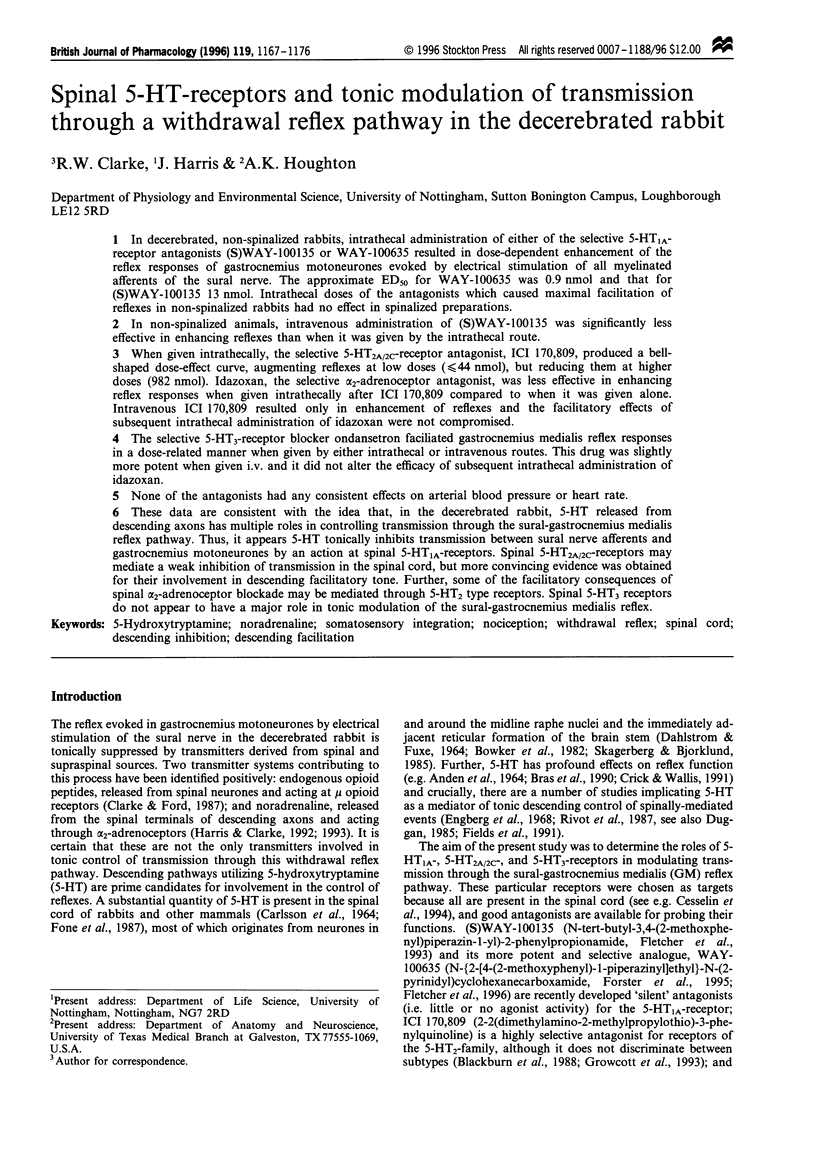
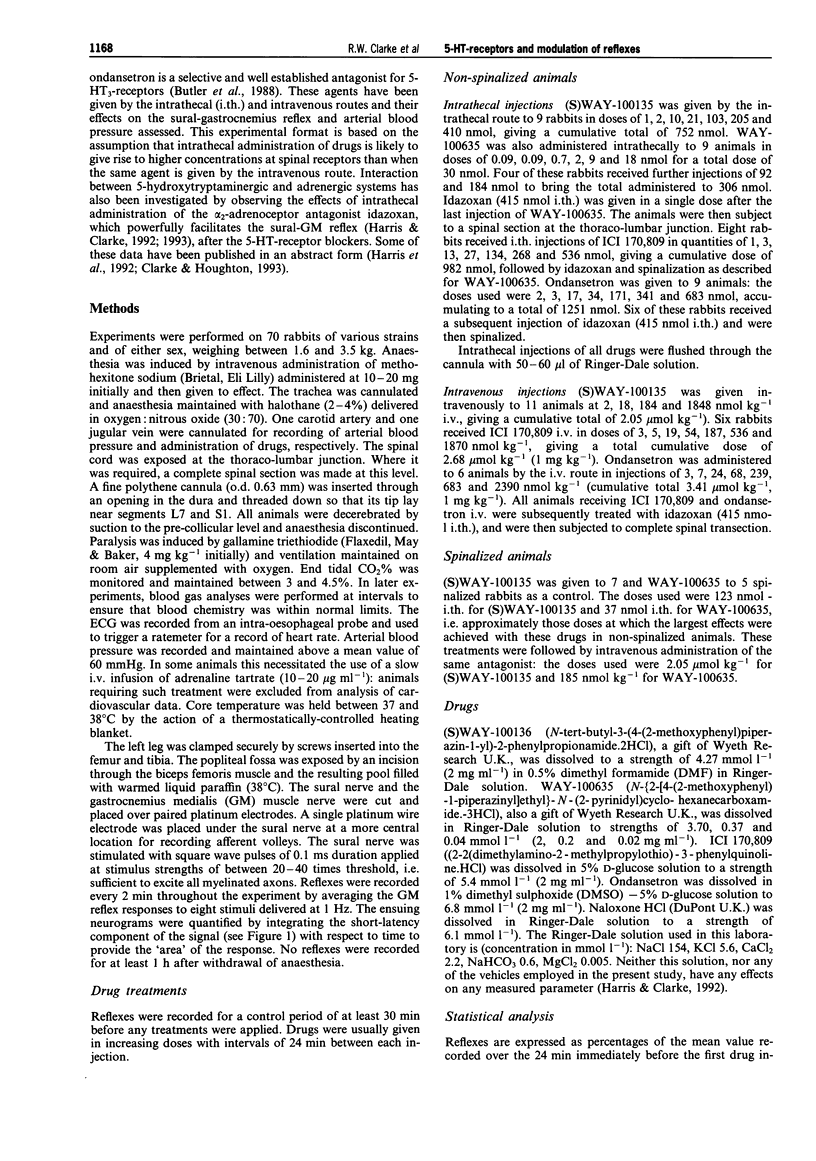
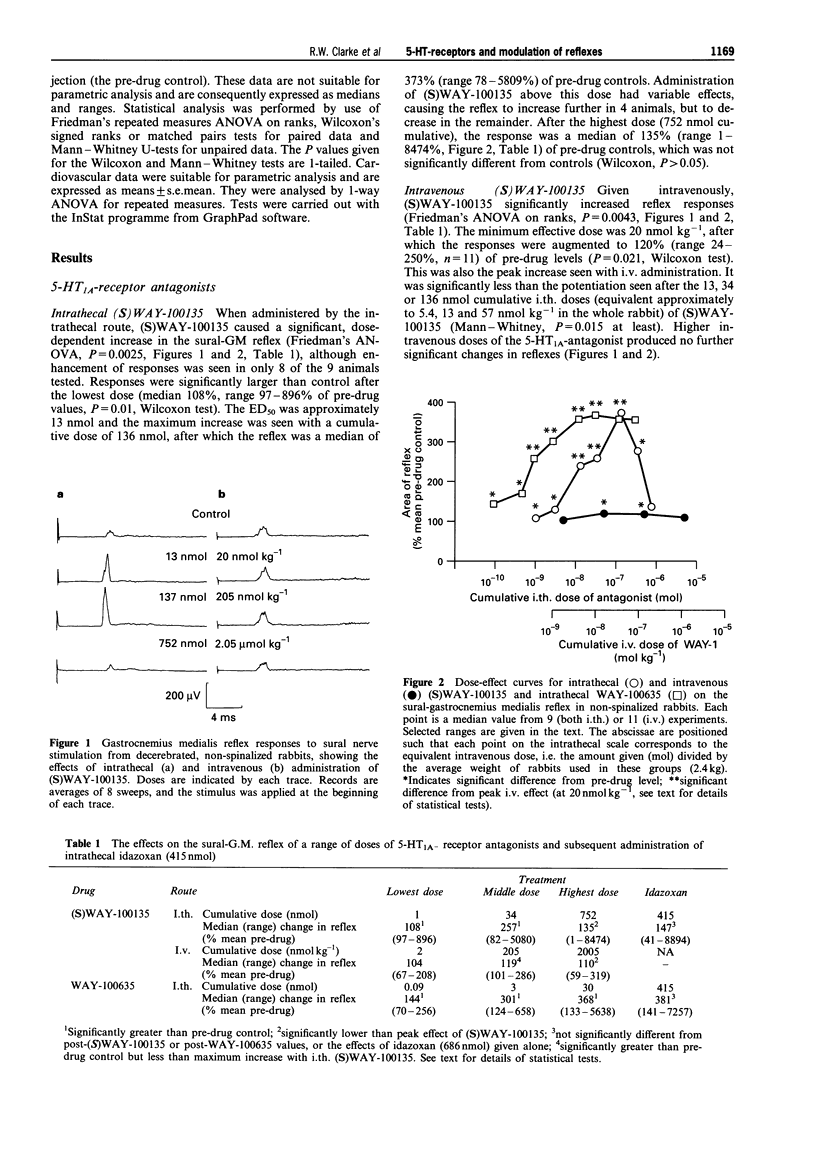
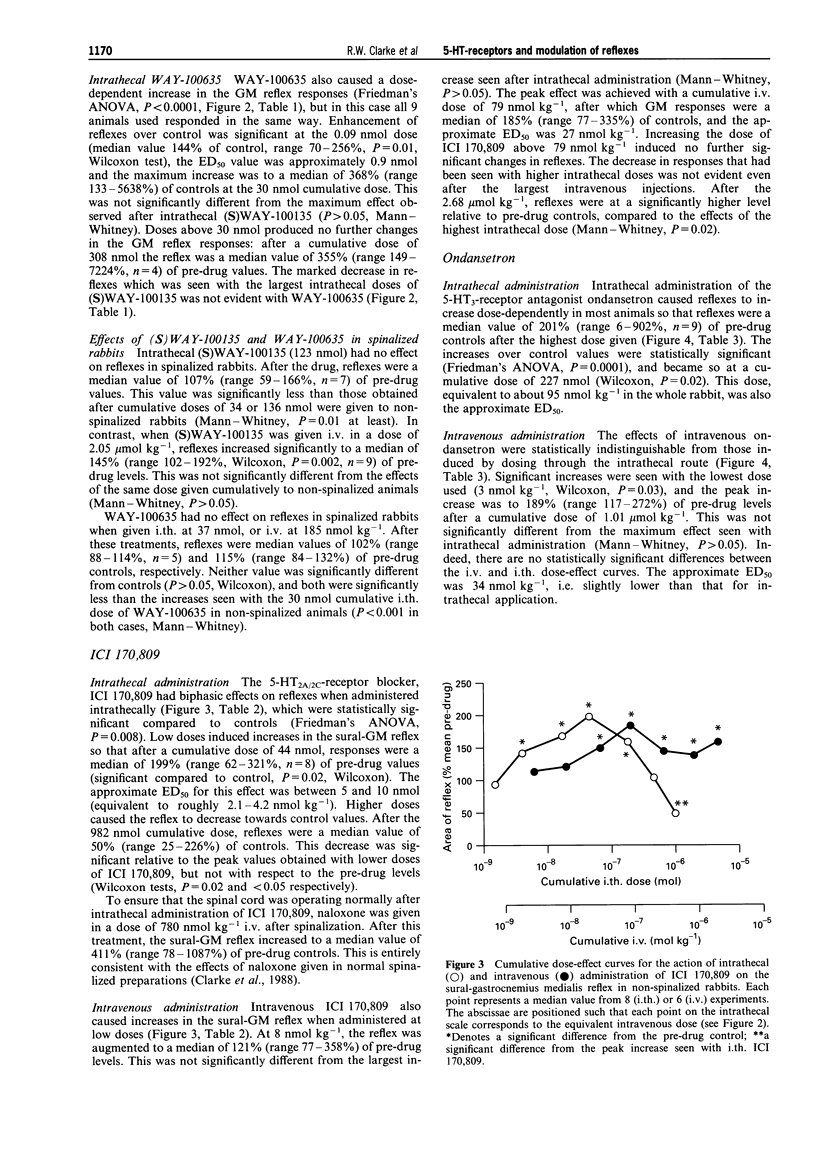
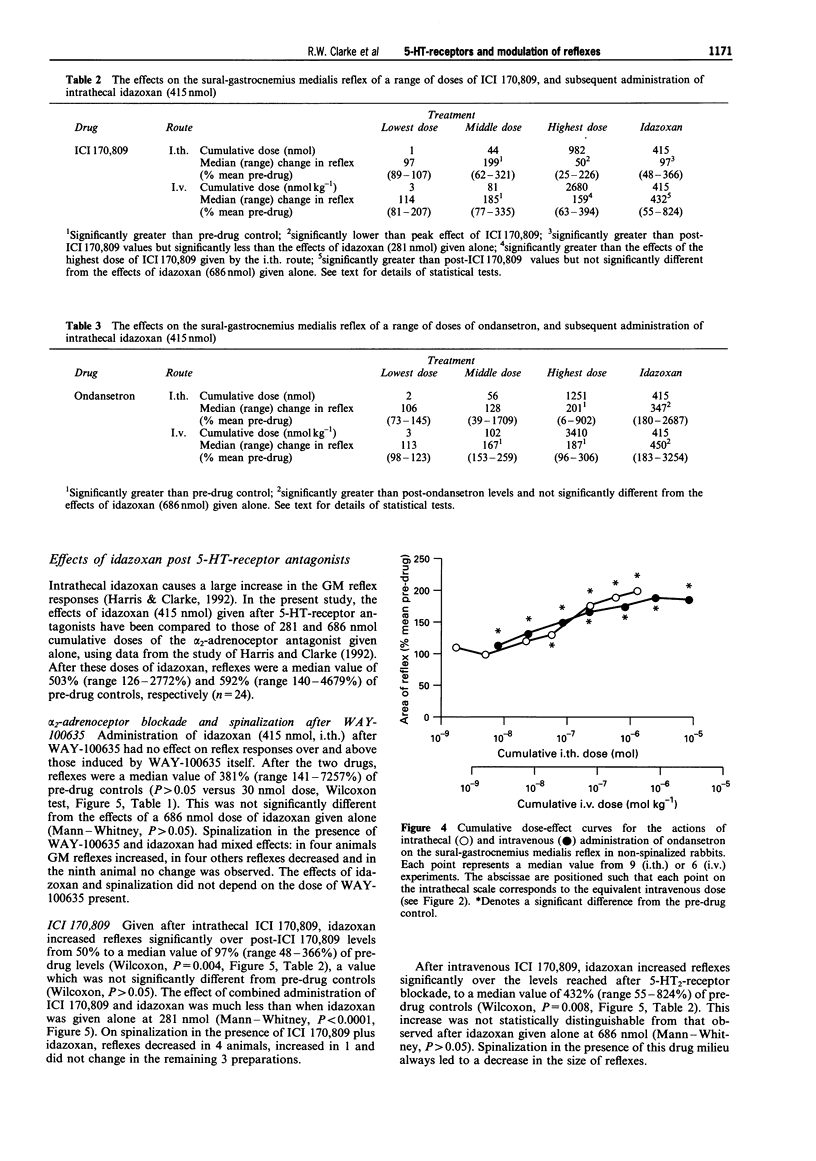
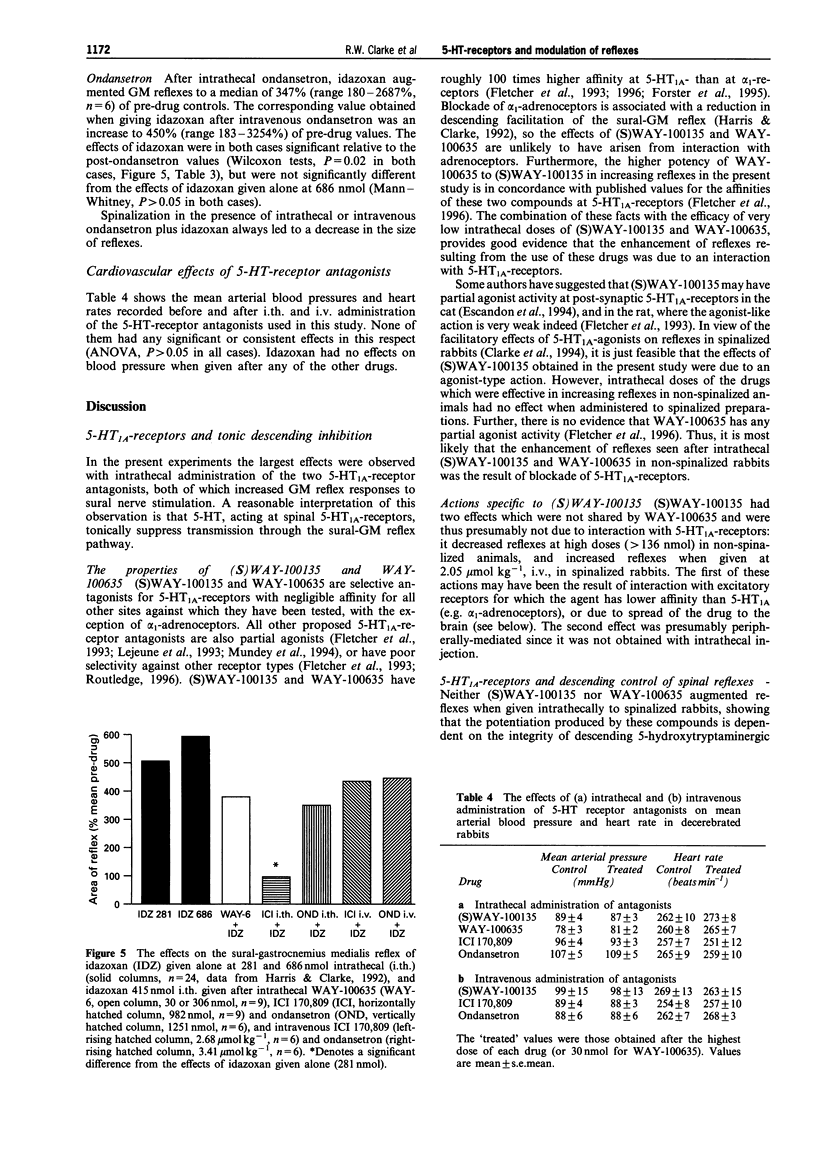
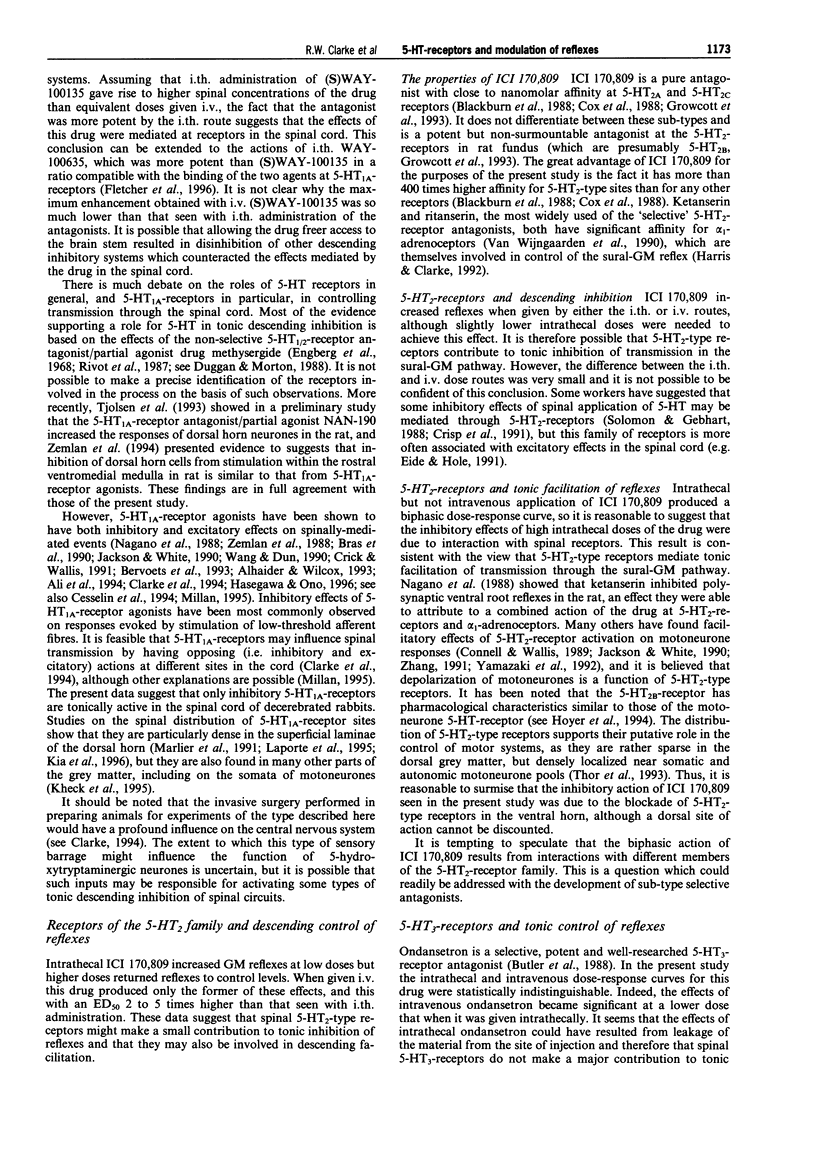
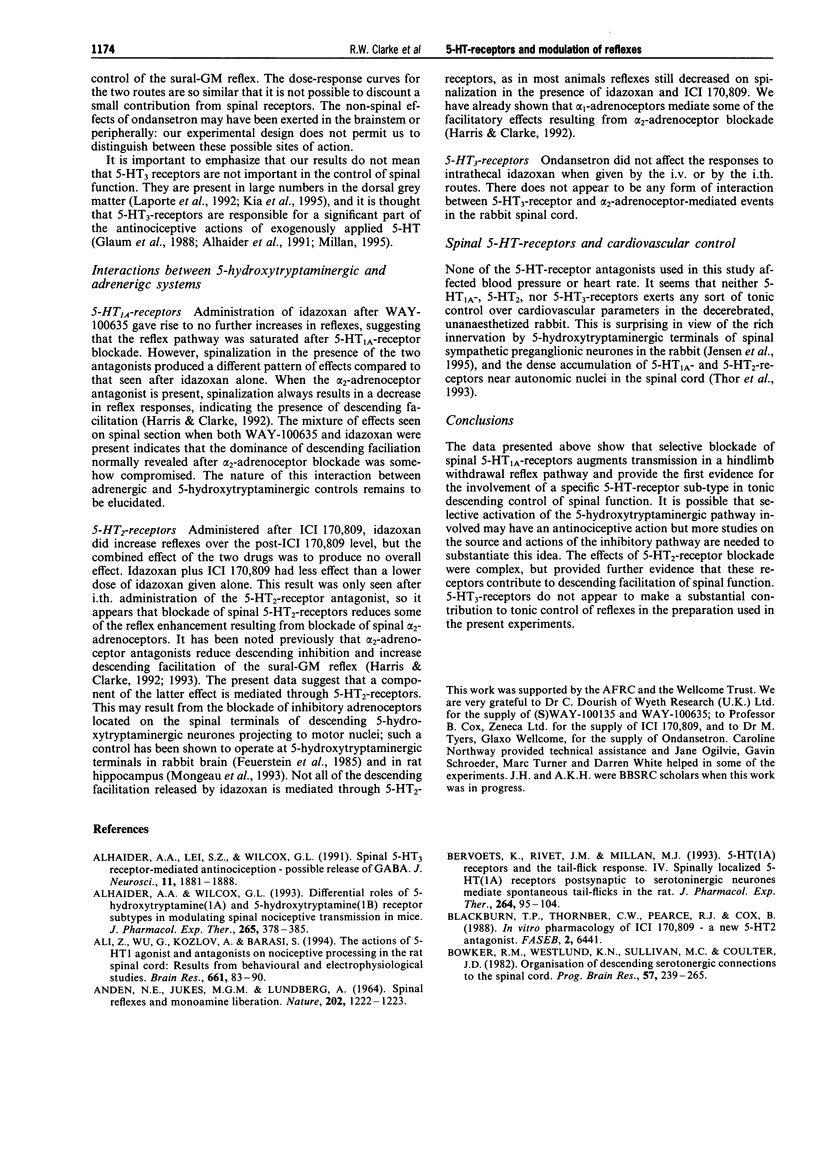

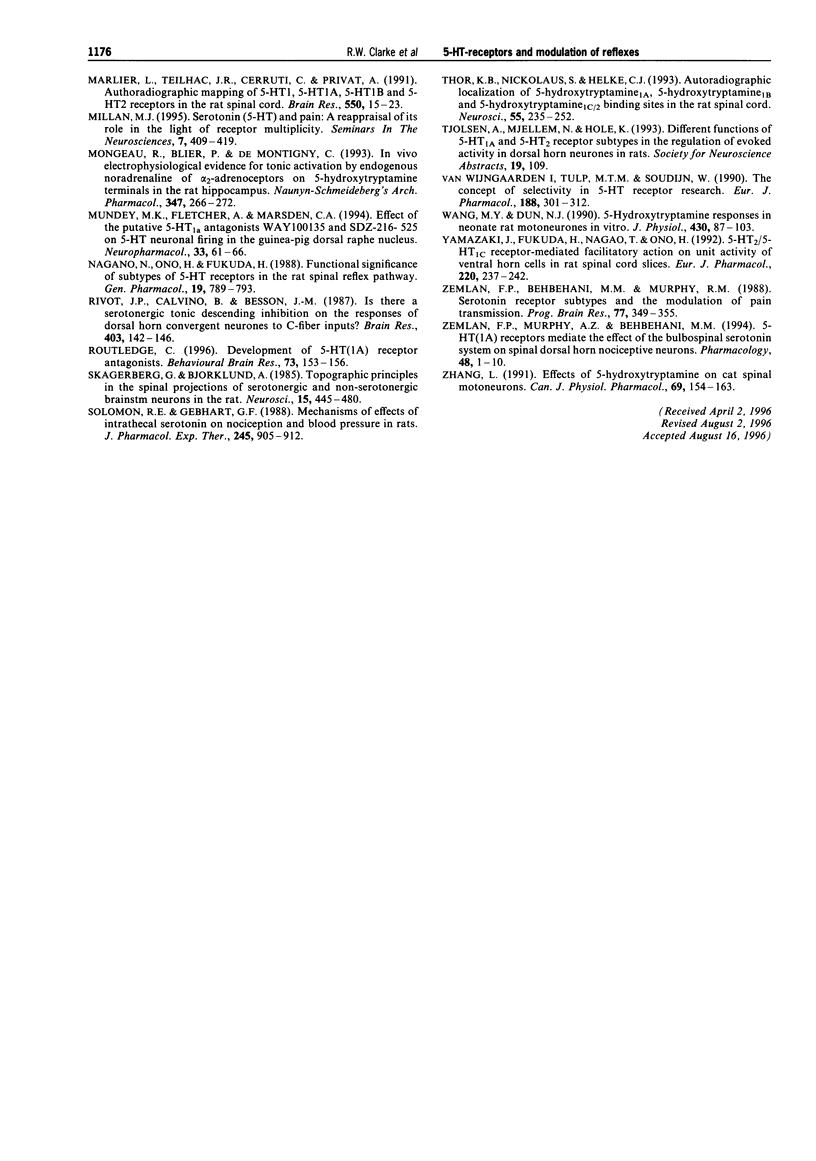
Selected References
These references are in PubMed. This may not be the complete list of references from this article.
- ANDEN N. E., JUKES M. G., LUNDBERG A. SPINAL REFLEXES AND MONOAMINE LIBERATION. Nature. 1964 Jun 20;202:1222–1223. doi: 10.1038/2021222a0. [DOI] [PubMed] [Google Scholar]
- Alhaider A. A., Lei S. Z., Wilcox G. L. Spinal 5-HT3 receptor-mediated antinociception: possible release of GABA. J Neurosci. 1991 Jul;11(7):1881–1888. doi: 10.1523/JNEUROSCI.11-07-01881.1991. [DOI] [PMC free article] [PubMed] [Google Scholar]
- Alhaider A. A., Wilcox G. L. Differential roles of 5-hydroxytryptamine1A and 5-hydroxytryptamine1B receptor subtypes in modulating spinal nociceptive transmission in mice. J Pharmacol Exp Ther. 1993 Apr;265(1):378–385. [PubMed] [Google Scholar]
- Ali Z., Wu G., Kozlov A., Barasi S. The actions of 5-HT1 agonists and antagonists on nociceptive processing in the rat spinal cord: results from behavioural and electrophysiological studies. Brain Res. 1994 Oct 24;661(1-2):83–90. doi: 10.1016/0006-8993(94)91184-3. [DOI] [PubMed] [Google Scholar]
- Bervoets K., Rivet J. M., Millan M. J. 5-HT1A receptors and the tail-flick response. IV. Spinally localized 5-HT1A receptors postsynaptic to serotoninergic neurones mediate spontaneous tail-flicks in the rat. J Pharmacol Exp Ther. 1993 Jan;264(1):95–104. [PubMed] [Google Scholar]
- Bowker R. M., Westlund K. N., Sullivan M. C., Coulter J. D. Organization of descending serotonergic projections to the spinal cord. Prog Brain Res. 1982;57:239–265. doi: 10.1016/S0079-6123(08)64132-1. [DOI] [PubMed] [Google Scholar]
- Bras H., Jankowska E., Noga B., Skoog B. Comparison of Effects of Various Types of NA and 5-HT Agonists on Transmission from Group II Muscle Afferents in the Cat. Eur J Neurosci. 1990;2(12):1029–1039. doi: 10.1111/j.1460-9568.1990.tb00015.x. [DOI] [PubMed] [Google Scholar]
- Butler A., Hill J. M., Ireland S. J., Jordan C. C., Tyers M. B. Pharmacological properties of GR38032F, a novel antagonist at 5-HT3 receptors. Br J Pharmacol. 1988 Jun;94(2):397–412. doi: 10.1111/j.1476-5381.1988.tb11542.x. [DOI] [PMC free article] [PubMed] [Google Scholar]
- CARLSSON A., FALCK B., FUXE K., HILLARP N. A. CELLULAR LOCALIZATION OF MONOAMINES IN THE SPINAL CORD. Acta Physiol Scand. 1964 Jan-Feb;60:112–119. doi: 10.1111/j.1748-1716.1964.tb02874.x. [DOI] [PubMed] [Google Scholar]
- Clarke R. W., Ford T. W., Taylor J. S. Adrenergic and opioidergic modulation of a spinal reflex in the decerebrated rabbit. J Physiol. 1988 Oct;404:407–417. doi: 10.1113/jphysiol.1988.sp017296. [DOI] [PMC free article] [PubMed] [Google Scholar]
- Clarke R. W., Ford T. W. The contributions of mu-, delta- and kappa-opioid receptors to the actions of endogenous opioids on spinal reflexes in the rabbit. Br J Pharmacol. 1987 Jul;91(3):579–589. doi: 10.1111/j.1476-5381.1987.tb11251.x. [DOI] [PMC free article] [PubMed] [Google Scholar]
- Connell L. A., Wallis D. I. 5-Hydroxytryptamine depolarizes neonatal rat motorneurones through a receptor unrelated to an identified binding site. Neuropharmacology. 1989 Jun;28(6):625–634. doi: 10.1016/0028-3908(89)90142-1. [DOI] [PubMed] [Google Scholar]
- Crick H., Wallis D. I. Inhibition of reflex responses of neonate rat lumbar spinal cord by 5-hydroxytryptamine. Br J Pharmacol. 1991 Jul;103(3):1769–1775. doi: 10.1111/j.1476-5381.1991.tb09861.x. [DOI] [PMC free article] [PubMed] [Google Scholar]
- Crisp T., Stafinsky J. L., Spanos L. J., Uram M., Perni V. C., Donepudi H. B. Analgesic effects of serotonin and receptor-selective serotonin agonists in the rat spinal cord. Gen Pharmacol. 1991;22(2):247–251. doi: 10.1016/0306-3623(91)90441-8. [DOI] [PubMed] [Google Scholar]
- Duggan A. W., Morton C. R. Tonic descending inhibition and spinal nociceptive transmission. Prog Brain Res. 1988;77:193–211. doi: 10.1016/s0079-6123(08)62786-7. [DOI] [PubMed] [Google Scholar]
- Duggan A. W. Pharmacology of descending control systems. Philos Trans R Soc Lond B Biol Sci. 1985 Feb 19;308(1136):375–391. doi: 10.1098/rstb.1985.0038. [DOI] [PubMed] [Google Scholar]
- Eide P. K., Hole K. Different role of 5-HT1A and 5-HT2 receptors in spinal cord in the control of nociceptive responsiveness. Neuropharmacology. 1991 Jul;30(7):727–731. doi: 10.1016/0028-3908(91)90180-j. [DOI] [PubMed] [Google Scholar]
- Engberg I., Lundberg A., Ryall R. W. Is the tonic decerebrate inhibition of reflex paths mediated by monoaminergic pathways? Acta Physiol Scand. 1968 Jan-Feb;72(1):123–133. doi: 10.1111/j.1748-1716.1968.tb03834.x. [DOI] [PubMed] [Google Scholar]
- Escandon N. A., Zimmermann D. C., McCall R. B. Characterization of the serotonin1A receptor antagonist activity of WAY-100135 and spiperone. J Pharmacol Exp Ther. 1994 Jan;268(1):441–447. [PubMed] [Google Scholar]
- Feuerstein T. J., Hertting G., Jackisch R. Endogenous noradrenaline as modulator of hippocampal serotonin (5-HT)-release. Dual effects of yohimbine, rauwolscine and corynanthine as alpha-adrenoceptor antagonists and 5-HT-receptor agonists. Naunyn Schmiedebergs Arch Pharmacol. 1985 May;329(3):216–221. doi: 10.1007/BF00501871. [DOI] [PubMed] [Google Scholar]
- Fields H. L., Heinricher M. M., Mason P. Neurotransmitters in nociceptive modulatory circuits. Annu Rev Neurosci. 1991;14:219–245. doi: 10.1146/annurev.ne.14.030191.001251. [DOI] [PubMed] [Google Scholar]
- Fletcher A., Bill D. J., Bill S. J., Cliffe I. A., Dover G. M., Forster E. A., Haskins J. T., Jones D., Mansell H. L., Reilly Y. WAY100135: a novel, selective antagonist at presynaptic and postsynaptic 5-HT1A receptors. Eur J Pharmacol. 1993 Jun 24;237(2-3):283–291. doi: 10.1016/0014-2999(93)90280-u. [DOI] [PubMed] [Google Scholar]
- Fletcher A., Forster E. A., Bill D. J., Brown G., Cliffe I. A., Hartley J. E., Jones D. E., McLenachan A., Stanhope K. J., Critchley D. J. Electrophysiological, biochemical, neurohormonal and behavioural studies with WAY-100635, a potent, selective and silent 5-HT1A receptor antagonist. Behav Brain Res. 1996;73(1-2):337–353. doi: 10.1016/0166-4328(96)00118-0. [DOI] [PubMed] [Google Scholar]
- Fone K. C., Bennett G. W., Marsden C. A. Regional distribution of substance P- and thyrotrophin-releasing hormone-like immunoreactivity and indoleamines in the rabbit spinal cord. J Neurochem. 1987 Apr;48(4):1027–1032. doi: 10.1111/j.1471-4159.1987.tb05621.x. [DOI] [PubMed] [Google Scholar]
- Forster E. A., Cliffe I. A., Bill D. J., Dover G. M., Jones D., Reilly Y., Fletcher A. A pharmacological profile of the selective silent 5-HT1A receptor antagonist, WAY-100635. Eur J Pharmacol. 1995 Jul 25;281(1):81–88. doi: 10.1016/0014-2999(95)00234-c. [DOI] [PubMed] [Google Scholar]
- Glaum S. R., Proudfit H. K., Anderson E. G. Reversal of the antinociceptive effects of intrathecally administered serotonin in the rat by a selective 5-HT3 receptor antagonist. Neurosci Lett. 1988 Dec 19;95(1-3):313–317. doi: 10.1016/0304-3940(88)90677-5. [DOI] [PubMed] [Google Scholar]
- Growcott J. W., Cox B., Blackburn T. P. A pharmacological comparison of the receptors mediating contractile responses to 5-hydroxytryptamine in the rat isolated caudal artery and fundic strip. J Pharm Pharmacol. 1993 Oct;45(10):876–881. doi: 10.1111/j.2042-7158.1993.tb05612.x. [DOI] [PubMed] [Google Scholar]
- Harris J., Clarke R. W. An analysis of adrenergic influences on the sural-gastrocnemius reflex of the decerebrated rabbit. Exp Brain Res. 1992;92(2):310–317. doi: 10.1007/BF00227973. [DOI] [PubMed] [Google Scholar]
- Harris J., Clarke R. W. Motor and cardiovascular effects of selective alpha 2-adrenoceptor antagonists in the decerebrated rabbit. Eur J Pharmacol. 1993 Jun 24;237(2-3):323–328. doi: 10.1016/0014-2999(93)90285-p. [DOI] [PubMed] [Google Scholar]
- Hasegawa Y., Ono H. Effect of (+/-)-8-hydroxy-2-(di-n-propylamino)tetralin hydrobromide on spinal motor systems in anesthetized intact and spinalized rats. Eur J Pharmacol. 1996 Jan 11;295(2-3):211–214. doi: 10.1016/0014-2999(95)00759-8. [DOI] [PubMed] [Google Scholar]
- Hoyer D., Clarke D. E., Fozard J. R., Hartig P. R., Martin G. R., Mylecharane E. J., Saxena P. R., Humphrey P. P. International Union of Pharmacology classification of receptors for 5-hydroxytryptamine (Serotonin). Pharmacol Rev. 1994 Jun;46(2):157–203. [PubMed] [Google Scholar]
- Jackson D. A., White S. R. Receptor subtypes mediating facilitation by serotonin of excitability of spinal motoneurons. Neuropharmacology. 1990 Sep;29(9):787–797. doi: 10.1016/0028-3908(90)90151-g. [DOI] [PubMed] [Google Scholar]
- Jensen I., Llewellyn-Smith I. J., Pilowsky P., Minson J. B., Chalmers J. Serotonin inputs to rabbit sympathetic preganglionic neurons projecting to the superior cervical ganglion or adrenal medulla. J Comp Neurol. 1995 Mar 13;353(3):427–438. doi: 10.1002/cne.903530310. [DOI] [PubMed] [Google Scholar]
- Kheck N. M., Gannon P. J., Azmitia E. C. 5-HT1A receptor localization on the axon hillock of cervical spinal motoneurons in primates. J Comp Neurol. 1995 May 1;355(2):211–220. doi: 10.1002/cne.903550205. [DOI] [PubMed] [Google Scholar]
- Kia H. K., Miquel M. C., Brisorgueil M. J., Daval G., Riad M., El Mestikawy S., Hamon M., Vergé D. Immunocytochemical localization of serotonin1A receptors in the rat central nervous system. J Comp Neurol. 1996 Feb 5;365(2):289–305. doi: 10.1002/(SICI)1096-9861(19960205)365:2<289::AID-CNE7>3.0.CO;2-1. [DOI] [PubMed] [Google Scholar]
- Kia H. K., Miquel M. C., McKernan R. M., Laporte A. M., Lombard M. C., Bourgoin S., Hamon M., Vergé D. Localization of 5-HT3 receptors in the rat spinal cord: immunohistochemistry and in situ hybridization. Neuroreport. 1995 Jan 26;6(2):257–261. doi: 10.1097/00001756-199501000-00008. [DOI] [PubMed] [Google Scholar]
- Laporte A. M., Fattaccini C. M., Lombard M. C., Chauveau J., Hamon M. Effects of dorsal rhizotomy and selective lesion of serotonergic and noradrenergic systems on 5-HT1A, 5-HT1B, and 5-HT3 receptors in the rat spinal cord. J Neural Transm Gen Sect. 1995;100(3):207–223. doi: 10.1007/BF01276459. [DOI] [PubMed] [Google Scholar]
- Laporte A. M., Koscielniak T., Ponchant M., Vergé D., Hamon M., Gozlan H. Quantitative autoradiographic mapping of 5-HT3 receptors in the rat CNS using [125I]iodo-zacopride and [3H]zacopride as radioligands. Synapse. 1992 Apr;10(4):271–281. doi: 10.1002/syn.890100402. [DOI] [PubMed] [Google Scholar]
- Lejeune F., Rivet J. M., Gobert A., Canton H., Millan M. J. WAY 100,135 and (-)-tertatolol act as antagonists at both 5-HT1A autoreceptors and postsynaptic 5-HT1A receptors in vivo. Eur J Pharmacol. 1993 Aug 24;240(2-3):307–310. doi: 10.1016/0014-2999(93)90915-5. [DOI] [PubMed] [Google Scholar]
- Marlier L., Teilhac J. R., Cerruti C., Privat A. Autoradiographic mapping of 5-HT1, 5-HT1A, 5-HT1B and 5-HT2 receptors in the rat spinal cord. Brain Res. 1991 May 31;550(1):15–23. doi: 10.1016/0006-8993(91)90400-p. [DOI] [PubMed] [Google Scholar]
- Mongeau R., Blier P., de Montigny C. In vivo electrophysiological evidence for tonic activation by endogenous noradrenaline of alpha 2-adrenoceptors on 5-hydroxytryptamine terminals in the rat hippocampus. Naunyn Schmiedebergs Arch Pharmacol. 1993 Mar;347(3):266–272. doi: 10.1007/BF00167444. [DOI] [PubMed] [Google Scholar]
- Mundey M. K., Fletcher A., Marsden C. A. Effect of the putative 5-HT1A antagonists WAY100135 and SDZ 216-525 on 5-HT neuronal firing in the guinea-pig dorsal raphe nucleus. Neuropharmacology. 1994 Jan;33(1):61–66. doi: 10.1016/0028-3908(94)90097-3. [DOI] [PubMed] [Google Scholar]
- Nagano N., Ono H., Fukuda H. Functional significance of subtypes of 5-HT receptors in the rat spinal reflex pathway. Gen Pharmacol. 1988;19(6):789–793. [PubMed] [Google Scholar]
- Rivot J. P., Calvino B., Besson J. M. Is there a serotonergic tonic descending inhibition on the responses of dorsal horn convergent neurons to C-fibre inputs? Brain Res. 1987 Feb 10;403(1):142–146. doi: 10.1016/0006-8993(87)90133-8. [DOI] [PubMed] [Google Scholar]
- Routledge C. Development of 5-HT1A receptor antagonists. Behav Brain Res. 1996;73(1-2):153–156. doi: 10.1016/0166-4328(96)00088-5. [DOI] [PubMed] [Google Scholar]
- Skagerberg G., Björklund A. Topographic principles in the spinal projections of serotonergic and non-serotonergic brainstem neurons in the rat. Neuroscience. 1985 Jun;15(2):445–480. doi: 10.1016/0306-4522(85)90225-8. [DOI] [PubMed] [Google Scholar]
- Solomon R. E., Gebhart G. F. Mechanisms of effects of intrathecal serotonin on nociception and blood pressure in rats. J Pharmacol Exp Ther. 1988 Jun;245(3):905–912. [PubMed] [Google Scholar]
- Thor K. B., Nickolaus S., Helke C. J. Autoradiographic localization of 5-hydroxytryptamine1A, 5-hydroxytryptamine1B and 5-hydroxytryptamine1C/2 binding sites in the rat spinal cord. Neuroscience. 1993 Jul;55(1):235–252. doi: 10.1016/0306-4522(93)90469-v. [DOI] [PubMed] [Google Scholar]
- Wang M. Y., Dun N. J. 5-Hydroxytryptamine responses in neonate rat motoneurones in vitro. J Physiol. 1990 Nov;430:87–103. doi: 10.1113/jphysiol.1990.sp018283. [DOI] [PMC free article] [PubMed] [Google Scholar]
- Yamazaki J., Fukuda H., Nagao T., Ono H. 5-HT2/5-HT1C receptor-mediated facilitatory action on unit activity of ventral horn cells in rat spinal cord slices. Eur J Pharmacol. 1992 Sep 22;220(2-3):237–242. doi: 10.1016/0014-2999(92)90753-q. [DOI] [PubMed] [Google Scholar]
- Zemlan F. P., Behbehani M. M., Murphy R. M. Serotonin receptor subtypes and the modulation of pain transmission. Prog Brain Res. 1988;77:349–355. doi: 10.1016/s0079-6123(08)62801-0. [DOI] [PubMed] [Google Scholar]
- Zemlan F. P., Murphy A. Z., Behbehani M. M. 5-HT1A receptors mediate the effect of the bulbospinal serotonin system on spinal dorsal horn nociceptive neurons. Pharmacology. 1994 Jan;48(1):1–10. doi: 10.1159/000139156. [DOI] [PubMed] [Google Scholar]
- Zhang L. Effects of 5-hydroxytryptamine on cat spinal motoneurons. Can J Physiol Pharmacol. 1991 Feb;69(2):154–163. doi: 10.1139/y91-022. [DOI] [PubMed] [Google Scholar]
- van Wijngaarden I., Tulp M. T., Soudijn W. The concept of selectivity in 5-HT receptor research. Eur J Pharmacol. 1990 Jun 12;188(6):301–312. doi: 10.1016/0922-4106(90)90190-9. [DOI] [PubMed] [Google Scholar]


